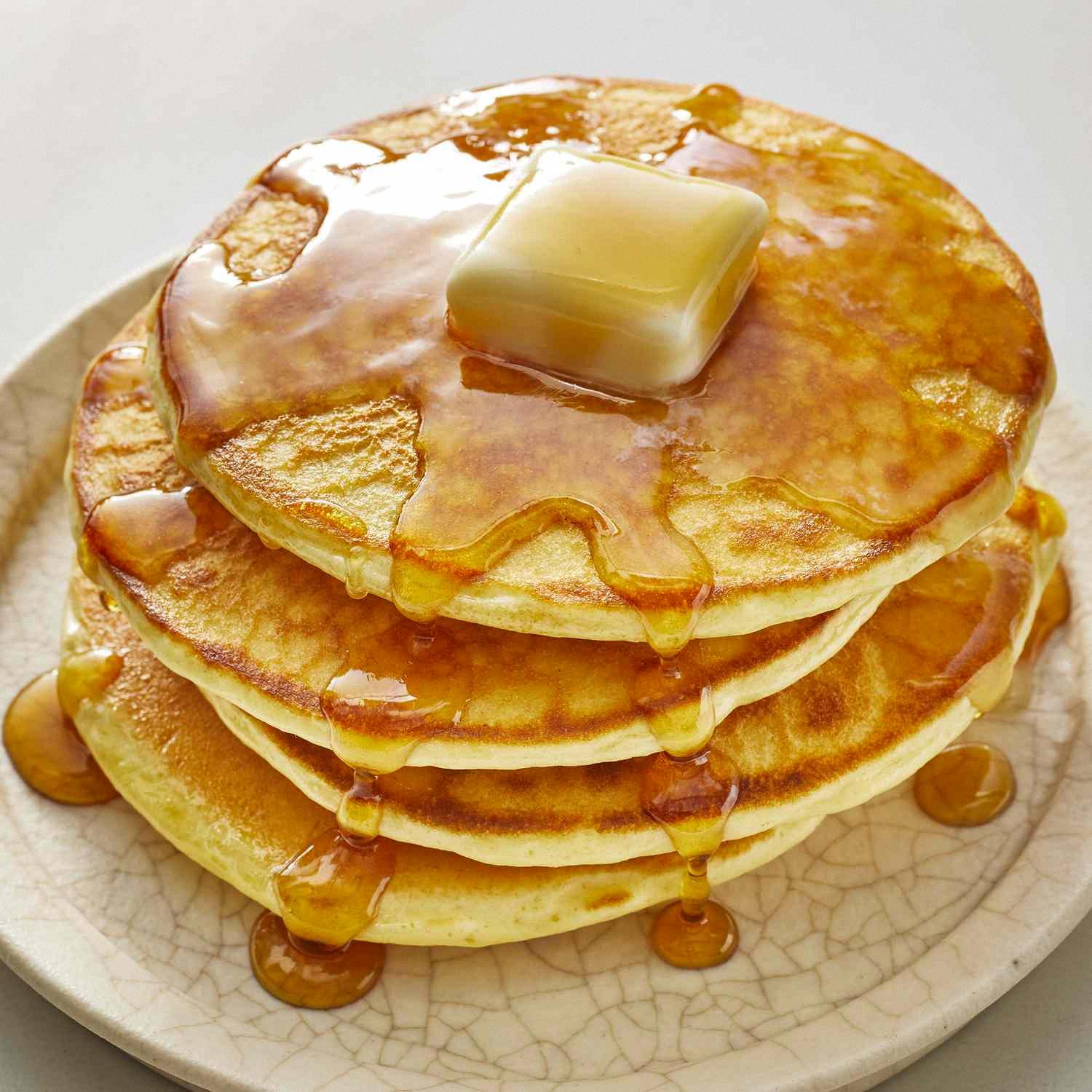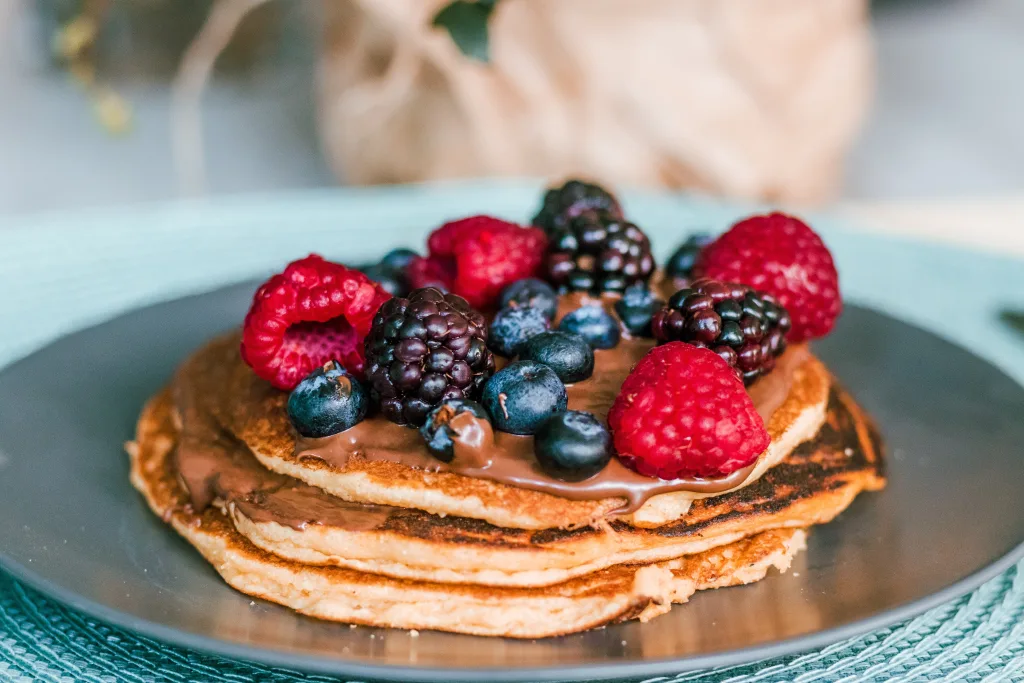Pancakes, a beloved breakfast staple enjoyed by people all over the world, have a long and fascinating history. While it is difficult to pinpoint exactly who invented pancakes, their origins can be traced back to ancient civilizations.
The earliest recorded mention of pancakes dates back to 600 BC in ancient Greece. It was Hesiod, a Greek poet, who first mentioned these delectable treats in his writings. However, the pancakes of that time were quite different from what we are familiar with today. They were made using ingredients such as wheat flour, olive oil, honey, and curdled milk.
Interestingly, evidence suggests that our prehistoric ancestors may have also enjoyed pancakes. Through the analysis of starch grains found on grinding tools dating back 30,000 years, researchers have discovered that Stone Age cooks made flour from cattails and ferns. This flour was likely mixed with water and then baked on a hot, possibly greased, rock. These primitive pancakes would have provided sustenance and nourishment to our early human predecessors.
Moving forward in history, pancakes gained popularity across North America and Canada. The origins of the traditional pancake recipe we are familiar with today can be traced back to Germany. German immigrants who settled in the United States in the eighteenth and nineteenth centuries brought with them the recipe for Pfannkuchen, a type of pancake.
Pancakes quickly became a beloved comfort food in the Americas. Early explorers encountered the native Narraganset Indians enjoying a type of pancake called ‘nokehick,’ which was made from a soft batter. The early white settlers referred to it as ‘no cake.’ This demonstrates the long-standing presence of pancakes in American cuisine.
The invention of pancakes, however, cannot be attributed to a single individual. Instead, it is a culinary creation that evolved over time, shaped by the different cultures and civilizations that embraced them. From ancient Greece to prehistoric times and the influence of German immigrants, pancakes have become an integral part of breakfast menus worldwide.
Today, pancakes continue to be a beloved breakfast choice for many. They can be enjoyed in various forms and flavors, from classic buttermilk pancakes to creative variations like blueberry or chocolate chip pancakes. Whether served with maple syrup, butter, or other sweet or savory toppings, pancakes remain a timeless and delicious treat that has conquered the hearts and taste buds of people throughout history.
While the exact inventor of pancakes remains a mystery, their existence can be traced back to ancient civilizations and the culinary traditions of different cultures. The evolution of pancakes over time has led to the delightful breakfast staple we know and love today. So, next time you enjoy a stack of fluffy pancakes, remember the rich history behind this beloved dish.
Where Did Pancakes Originally Come From?
Pancakes, a popular breakfast dish enjoyed by people around the world, have a long and fascinating history. These delectable treats can trace their origins back to ancient times, specifically in ancient Greece.
The earliest recorded mention of pancakes can be found in the works of a poet from ancient Greece, dating back to 600 BC. However, it is important to note that the pancakes of that time were quite different from the ones we are familiar with today.
In ancient Greece, pancakes were made using a combination of wheat flour, olive oil, honey, and curdled milk. This mixture was then cooked on a hot stone or a griddle. As you can see, the ingredients and cooking methods vary from what we commonly use now.
Over time, pancakes evolved and spread to different parts of the world, each region putting its own unique twist on the recipe. Here are some interesting variations:
1. French Crepes: These thin, delicate pancakes are a staple in French cuisine. They are typically made with a thin batter of flour, milk, eggs, and a touch of sugar. Crepes can be filled with a variety of sweet or savory fillings, such as Nutella, cheese, or ham.
2. American Pancakes: These fluffy and thick pancakes are a beloved breakfast item in the United States. They are typically made with a batter consisting of flour, eggs, milk, baking powder, and a bit of sugar. American pancakes are often served stacked high and topped with butter, maple syrup, or fruit.
3. Chinese Scallion Pancakes: In Chinese cuisine, scallion pancakes are a popular street food. These savory pancakes are made by mixing flour, water, and chopped scallions. The dough is then rolled out, folded, and pan-fried until crispy.
4. Indian Dosas: Dosas are a traditional Indian pancake made from fermented rice and lentil batter. They are thin and crispy, often served with chutneys and spicy potato fillings. Dosas are a staple in South Indian cuisine.
As you can see, pancakes have a rich and diverse history, with variations found in different cultures across the globe. From the ancient Greek pancakes to the modern-day fluffy stacks, this beloved breakfast treat has come a long way.

How Did Pancakes Get Invented?
Pancakes, a beloved breakfast staple, have a long and fascinating history. While it is difficult to pinpoint the exact origin of pancakes, various civilizations throughout history have contributed to their development.
1. Ancient Origins: The earliest evidence of pancake-like creations can be traced back to prehistoric times. Analyses of grinding tools dating back around 30,000 years suggest that our Stone Age ancestors may have made flour from cattails and ferns. This flour was likely mixed with water and cooked on a hot rock, potentially greased, to create a primitive form of pancake.
2. Ancient Greece and Rome: Pancakes as we know them today began to take shape during the ancient Greek and Roman periods. Greeks made a pancake-like dish called “τηγανίτης” (tēganitēs) by combining wheat flour, olive oil, honey, and curdled milk. Romans had a similar dish called “alita dolcia,” which was made with milk, eggs, flour, and spices.
3. Middle Ages: Pancakes continued to evolve during the Middle Ages. In Europe, pancakes were often made with buckwheat or rye flour, as wheat was relatively expensive. They were commonly cooked on large, flat metal griddles or in open hearths. Pancakes were enjoyed during various religious festivals and celebrations.
4. Shrove Tuesday and Lent: The tradition of eating pancakes on Shrove Tuesday, also known as Pancake Day, has its roots in religious customs. Shrove Tuesday falls before the start of Lent, a period of fasting and abstinence in Christianity. To use up rich ingredients like eggs, milk, and butter before Lent, people would make pancakes. This tradition is still observed in many countries today.
5. International Variations: Pancakes have taken on various forms and flavors around the world. In France, for example, they have crepes, thin and delicate pancakes often filled with sweet or savory fillings. In Japan, they have fluffy and thick pancakes called “hotcakes.” Each culture has its own unique take on this versatile dish.
6. Modern Era: With the advent of modern cooking techniques and appliances, pancakes have become more accessible and convenient to make. Pancake mixes and pancake-making tools have made it easier for people to enjoy homemade pancakes. Moreover, pancakes have expanded beyond breakfast and are now enjoyed as a versatile dish for any meal.
The invention and evolution of pancakes can be traced back to prehistoric times, with our ancestors experimenting with different ingredients and cooking methods. Throughout the ages, pancakes have been shaped by various cultures and traditions, becoming the beloved dish we enjoy today.
Did Canada Invent Pancakes?
Canada did not invent pancakes. The origin of pancakes can be traced back to Germany. The traditional recipe for pancakes, known as Pfannkuchen, was brought to North America by German immigrants in the 18th and 19th centuries. However, pancakes have become a popular breakfast dish in Canada and across North America. They are typically made from a batter consisting of starchy ingredients, eggs, milk, and butter. The batter is cooked on a griddle or frying pan, resulting in a flat, round cake-like structure. Pancakes are often served with toppings such as maple syrup, fruit, or whipped cream, making them a beloved breakfast staple in Canada and beyond.
Here are some key points about the origin of pancakes:
– Pancakes are believed to have originated in Germany, specifically with the traditional Pfannkuchen recipe.
– German immigrants brought the recipe to North America in the 18th and 19th centuries.
– Pancakes are made from a batter consisting of starchy ingredients, eggs, milk, and butter.
– They are typically cooked on a griddle or frying pan, resulting in a flat, round cake-like structure.
– Pancakes have become a popular breakfast dish in Canada and across North America, often served with various toppings such as maple syrup, fruit, or whipped cream.
While Canada did not invent pancakes, they have embraced this delicious breakfast dish and made it their own.
Are Pancakes Native American?
Pancakes have origins in Native American cuisine. Early explorers in the Americas discovered that the native Narraganset Indians were enjoying a type of pancake called ‘nokehick,’ which means “it is soft” in their language. These pancakes were made using a soft batter and were referred to as ‘no cake’ by the early white settlers.
To provide further information, here are some key points about the Native American connection to pancakes:
1. Native Americans, particularly the Narraganset Indians, were known to have been making pancakes long before European settlers arrived in the Americas.
2. The Native American pancake, known as ‘nokehick’ or ‘no cake,’ was made from a soft batter.
3. The use of soft batter in making pancakes is a distinctive feature of Native American pancake recipes.
4. The early white settlers observed and adopted the Native American pancake-making techniques, leading to the spread of pancakes throughout the Americas and eventually becoming a popular comfort food worldwide.
Pancakes have a Native American origin, with the Narraganset Indians being among the first to enjoy ‘nokehick’ or ‘no cake’ pancakes made from a soft batter.

Conclusion
The exact origins of pancakes are difficult to pinpoint with certainty. The first recorded mention of pancakes dates back to ancient Greece in 600 BC, where they were made with wheat flour, olive oil, honey, and curdled milk. However, even our prehistoric ancestors may have been enjoying a primitive version of pancakes made from cattails and ferns mixed with water and cooked on hot rocks.
While the ancient Greeks and prehistoric humans may have laid the foundation for pancake making, it is likely that the modern version we know today was influenced by German immigrants who settled in the United States in the eighteenth and nineteenth centuries. The traditional Pfannkuchen recipe brought by these immigrants is similar to the pancakes consumed across North America and Canada, made from a batter consisting of flour, eggs, milk, and butter.
Furthermore, early explorers in the Americas discovered the native Narraganset Indians enjoying a pancake-like dish called ‘nokehick’ or ‘no cake’, made from a soft batter. This suggests that pancakes, in some form, were already a beloved comfort food in the Americas before the arrival of European settlers.
While the exact inventor of pancakes remains unknown, it is clear that they have a long and rich history spanning cultures and centuries. From the ancient Greeks and prehistoric humans to German immigrants and Native American tribes, pancakes have evolved and adapted to become the beloved breakfast treat enjoyed by millions today.
